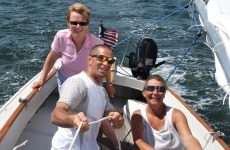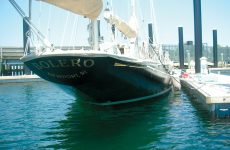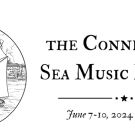Guest perspective: Christopher Birch

The author’s daughter, Heidi, and dog, Pedro, relax outside their “vessel.” Photo by Christopher Birch
“What’d you sail in on?” asked the man shaving at the sink next to me.
“A Caravan 18,” I replied, pleased with my quick thinking and grateful for the shaving cream concealing my smirk. It was a beautiful August morning in Northeast Harbor, Maine, and my new friend and I were getting cleaned up in the Yachtsmen’s Building at the town dock.
“I see,” he continued, “and where did you cruise in from?”
“Boston,” I replied.
“Wow, that’s a long way in such a small boat. How long did it take you?”
“About six hours,” I told him.
“Holy cow! That must have been a rough ride, going so fast in such a small boat in open water.”
“Nope, it was a very smooth ride. Comfortable, too, with air conditioning and the Red Sox game on the radio. Coulda made better time if I hadn’t stopped at MacDonald’s,” I continued.
Now he was starting to catch on.
“Dodge makes a great van,” I said, confirming his suspicions.
Things were finally starting to look up on this, the third day of our trip. I was in between boats and had decided to take my daughter Heidi and dog Pedro for nine days of car camping along the Maine coast in my blue Dodge Grand Caravan. My previous summers had been spent sailing and this car camping was new to me. As is common for beginners, there were some complications at the start.
Our van caught a tailwind on our first day out of Boston, and by dinnertime we found ourselves staring across the border at a Molson beer sign on a pizza place in Canada. Canadian pizza sounded fun. There was a border crossing right there, so why not? I soon learned the answer to that question: It’s tricky business getting your eight-year-old daughter out of, and back into, the United States with zero identification. The Canadian customs officials were pleasant, and the pizza was good, but re-entry to the U.S. of A. took a while. We both answered lots of questions in separate rooms while the dog dutifully waited in the van.
Sample question: “Where do you plan to spend the night?” Answer: “In the van.”
Dodgy, is what we were.
Fortunately, we had the same answers to all the important questions. Too many hours, and very many phone calls later, father and daughter were reunited and sent on their way.
I was tired, the parking lot was flat and there was a bathroom, so we camped at the U.S. Customs and Border Protection facility. Trucks rumbled past with their headlamps splashing the inside of the van with light all night.
Walking back into our interrogation chambers with our toothbrushes in the morning, we looked like crazy squirrels who refused to leave an open Havahart trap. Dodgy, very dodgy.
On the map, the campground for night number two looked to be situated on a lovely stretch of coastal Maine. Upon check-in, we were assigned to a patch of dirt that looked like a sorry corner of Ohio. A glimpse of the sea was nowhere to be found. A stone’s throw to both the right and left sat gaggles of men clustered around matching 30 packs of beer competing in some sort of decibel derby. And there were mosquitoes. This camping thing was not going well. We needed salt air. I left my $8 camping fee and the dirt patch behind and set course for the sea.
More often than not, town piers have roomy, flat parking lots and bathrooms and picnic benches and nice views. When you think about it, these places are like great campgrounds where you don’t even have to pay to stay. I was on to something. Night number three in Northeast Harbor completely validated my theory. It was a win-win arrangement; the towns got our tourism dollar at their shops and restaurants, while we were freed from the back-corner dirt patches designated for campers and returned to the familiar sailing hubs we knew and loved.
After our visit to Acadia, we picked blueberries for Sal on Blue Hill and spent a delightful night in Bucks Harbor with our van nestled in between unoccupied cars that obviously belonged to fellow sailors. Our black dog subbed in for the black bear while berry picking and our day felt like it was snatched from the pages of McCloskey’s book.
The Belfast City Landing proved to be another memorable stop. A nearby dog-friendly café served us delicious Pemaquid oysters and we sat and watched the town bustle with all its summer energy on display. The Front Street Shipyard overflowed with yachts in various states of repair and construction. Heidi knew her way around boats pretty well by the time she was eight, but I don’t think it was until Belfast that she saw a 440-ton, 14-sling, 8-wheel travel lift and all the things it carries. The opposite of blueberries, but every bit as delicious.
In an effort to blend in, I worked on marinizing the van as we went. In Belfast, I found a slightly torn wind scoop in a dumpster and unspooled the better part of a roll of duct tape to mend the tear. The option package on my van didn’t include a forward hatch, but its sunroof served as a reasonable facsimile.
Hoisting the wind scoop remained a problem. The van was sorely lacking when it came to halyards, but a 10-foot fiberglass batten that I found lying in the dirt behind that same dumpster did the trick. I jammed its foot between the driver’s seat and the inboard arm rest. The sunroof hole formed a large and loose mast partners, and the top of the batten did an admirable job supporting the wind scoop – one very slick un-stayed rig. When parked facing into a moderate breeze, especially one just a bit off the starboard bow of the van, the contraption worked well. Most importantly, we looked and felt very salty.
Pulling into Tenants Harbor a day later brought back the memories. Having travelled there by boat so many times, it was interesting to approach from a new angle. (It’s a lot closer to Camden than you think!) Sitting on the deck at what was then called the Cod End Restaurant, we observed how remarkably low the low tide was beneath us while we feasted on lobster and ice cream. Post meal, we walked on the road past the general store and out along the waterfront toward Northern Island, just as we had done years earlier when visiting by boat. Then we reversed direction and walked past the great sculpture of St. George slaying his dragon and let the dog run free in the fog in the cemetery, just as we had done yesteryear.
Without routing factors like wind, tide, and fog, deciding where to go next became my biggest challenge. There were just too many options. We mixed in a few marinas and yacht clubs and even a lighthouse parking lot along the way. I can attest that it is much more pleasant to have the inside of your van illuminated by a lighthouse beam in Hancock County than by truck headlamps at the border crossing in Washington County. Just like on the boat, nine days wasn’t enough.
Cruising in the blue van was a delight. We never dragged anchor, I felt no obligation to listen to all the yelling and screaming on VHF16, and wind was never a factor as we came and went from the fuel pump. We didn’t have a keel or a rudder, but we were sailing again, and the living was good.
Christopher Birch is the proprietor of Birch Marine Inc. on Long Wharf in Boston, Mass., where he’s been building, maintaining and restoring boats for the past 34 years.









